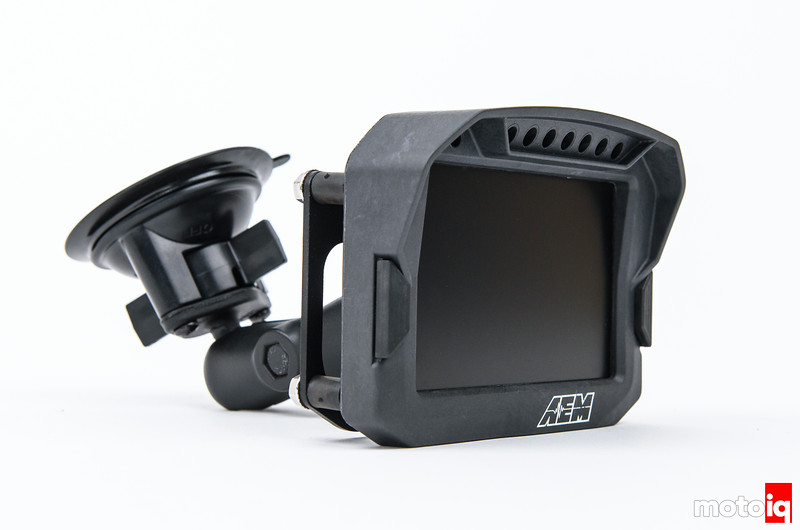
The Ram Mount, P/N, 30-5545 has a ball on a bracket that bolts to the back of the CD-5. The ball goes into the socket on the mount that attaches to the suction cup or tube clamp for roll cage installation. The suction cup is shown here and needs to be purchased separately from Ram Mounts.

The ball and socket allow the CD-5 to be installed in any orientation. No matter at what angle the mount is attached to the car, you can adjust it so you can view the CD-5.

In order to do vehicle dynamics data logging and track mapping, you need to get the optional GPS antenna P/N 30-2208. For additional telemetry data a Vehicle Dynamics Module (VDM) part# 30-2206 can also be connected to the CD-5. The VDM adds a 3-axis accelerometer and 3-axis gyrometer which provide lateral G, altitude, pitch, roll, and yaw data.

When only using the built-in GPS antenna, and not the optional VDM, this is where the GPS antenna plugs in. It uses a co-axial screw in type connector which is typical of many types of antenna.

On the top is the main wiring harness for the CD-5. It plugs into the back of the CD-5 and has an AEMnet CANBUS plug as well as a secondary CANBUS plug for other inputs. Here we have it plugged to a 12-volt AEMnet power plug P/N 30-2227 which grabs power from the vehicles cigarette lighter which makes moving the unit from car to car a snap. This comes in really handy when doing testing of several cars at a track day for instance. There are two additional input wires on the harness, one is to use with the OEM dash dimming feature to dim the display when the headlights are on. The other is to use as an event trigger for lap beacon setting. To use these features you can use P/N 30-3610 for the remote dash button kit.
Also pictured here is the OBDII CAN Adaptor cable P/N 30-2217. All you have to do is plug the CD-5 into your 2008 and later cars OBDII port and you have a fully functional data logging race dash hooked up in seconds! The plug has a pass-through function so it will not interfere with tuners like the Cobb Access Port and other similar products or OBDII scanners.




14 comments
Wish you guys would put the MSRP of items you write about in the article….though I suppose this is done by design to drive traffic to their website.
Just wish it didn’t have to be this way.
MSRPs can change with time.
I’m not buying this feeble excuse. Again, I think this is merely to drive traffic to manufacturers websites rather than making it convenient for the people who matter most: your readers. Most print magazine who do any product testing (including aftermarket automotive accessories and parts) print MSRP. And some even put the caveat “MSRP at time of printing”. And the time it takes to get to print is significantly longer than uploaded web content. I see no reason why this type of disclaimer can’t be done here.
Hi RA! Part of this may have to do with the multiple iterations of the dash. So, as of 6/13/2019:
30-5600 CD-5 Display: 999.00
30-5600F CD-5 Flat Panel Display: 940.00
30-5601 CD-5L Logging Display: 1318.48
30-5601F CD-5L Flat Panel Logging Display: 1239.99
30-5602 CD-5G GPS-enabled Display: 1115.48
30-5601F CD-5G Flat Panel GPS-enabled Display: 1040.00
30-5603 CD-5LG Logging/GPS-enabled Display: 1419.98
30-5601F CD-5G Flat Panel Logging/GPS-enabled Display: 1339.99
The 7″ versions start at 1340.00 and top out at 1740.00. Hope this helps!
The posts are not dated. And these articles stay up forever. So ten years down the road from now, someone will come onto the site and say, “hey, you listed this as the MSRP but that’s not the case.”
Also, does anyone ever buy at MSRP or buys from the first distributor they find? I don’t know about you, but I shop around.
Also, I spent 5 seconds to highlight “CD-5 Digital Dash Display”, did a copy/paste into google and instantly had prices at JEGS, Ostar Motorsports, and Ebay.
I like that there’s more players in the logging dash stuff than just the old standbys like Motec and AIM. I just wish that AEM had some high speed analog inputs. While it can apparently log at 1khz, I haven’t seen any way to get, say, shock pot data into it at that rate. Definitely a nice setup for most uses though.
Hi Dan, Appreciate your comment! The CD-5 delivers a fully customizable display with logging and GPS for under $1500, which we believe delivers a competitive advantage with respect to price and features, and we are pleased with how well it is being received. You are correct that while the dash can log individual channels at 1kHz, there are still limitations that come from the transmission speed of a sending device. For the vast majority of channels, most CAN Converters transfer at speeds well above what is required for attaining useful data for a large swath of track applications. We assume you are looking for shock pot logging at that speed for frequency analysis, which goes into the realm of burst logging and is typically used for very specialized analysis.
That’s exactly right; shock pots. Please don’t misunderstand – I know as a test engineer in my day job, my desires for data are pretty far out in left field and I can’t fault the CD5 series for not doing some of the more esoteric stuff. Everyone wants their perfect solution for affordable money though, don’t they? 😉
I honestly think I’m going to dig into documentation – I have a hypothesis that I could set up a CAN stream to feed a CD5 or CD5G from another logger.
We looked into this as we use the AQ1 and both the CD7. The AQ1 can easily do that 1000 hz shock pot sampling, and that is what we use. If you want to use the CD7, use the CAN adapter by Texense into AEMNet canbus channel on the CD7, that will allow you to sample up to 800 hz for the shock pots. Unfortunately there are not alot of analog to CAN adapters on the market that can handle the high sampling rates needed for dampers.
I said CD7, but same idea should work for the CD5 as well.
As a side note, the AEMdata software is pretty easy to use. Pretty intuitive, like the Motec software.
Yeah, I downloaded over the weekend and poked around – I really like what’s possible with the dash layouts compared to, say, the AIM dashes. That said, I have some math functions I want to try to implement that so far I haven’t found a good way to do in either dash; in broad terms, rate of change of a channel. I’m half tempted to homebrew an “advanced math box” to sit on the CANBUS and spit out calculated values; I really don’t want to look at Motec, or worse…
Great overview of a nice little data logger.